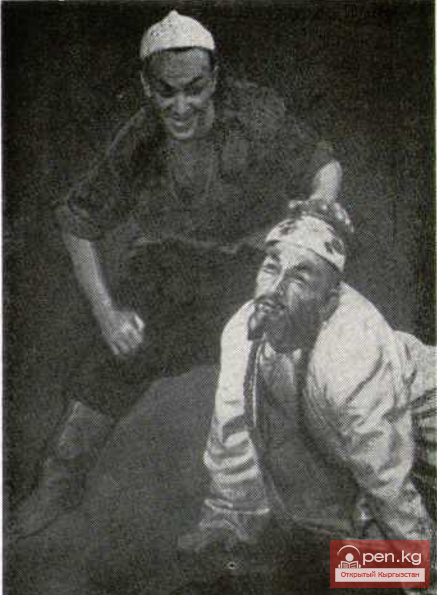
Evgeny Voevodkin as Kuyruchuk
The ballet was first staged in 1960 by N. Tugelov. The second production was carried out by N. Avaliani. Comparing both performances, it should be noted that the libretto did not undergo any significant changes.
The director N. Avaliani deepened some social characteristics of the characters, particularly that of Saribai. In the first version, he was portrayed as a foolish, spoiled son of a rich man, but now we see a cunning, malicious, and far from foolish wealthy man. This gives Kuyruchuk's antics a more purposeful nature.
In the second version, the fragmentary nature characteristic of the work as a whole has been somewhat overcome. The ballet depicts not the entire life of Kuyruchuk, but only separate episodes from it. N. Avaliani attempted to connect them more organically and logically conduct the character's line of behavior, although he still did not manage to complete this work.
Positive qualities of the new production include a comparative complexity and variety of choreographic means. N. Avaliani introduces movements characteristic of dances from other nations into Kyrgyz dance. This, in our opinion, enriches the ballet performance. For example, in the shepherds' dance, the dancers perform a squat while kicking their legs forward, reminiscent of the Georgian dance khorumi. A movement typical of Tatar dance can be seen in Kuyruchuk's variation in the third act, and so on. Thanks to all this, the new version brought a fresh breath to the ballet and extended its life.
For many years, the role of Kuyruchuk has been consistently performed by artist Evgeny Voevodkin (currently, this role is being prepared by U. Sarbagishev), who creates a truthful image of a man from the people. The actor is well aware of the habits and character traits of his hero. At the same time, he reveals in him traits of courage, the ability to find himself in time, not to get flustered, and endows him with clearly expressed class sympathies. Essentially, all of Kuyruchuk's pranks against the wealthy aim to ridicule their greed, cowardice, malice, and religious prejudices.
In E. Voevodkin's portrayal, the character develops through action. In each new scene, we see some new trait.
If at first Kuyruchuk seems cheerful and good-natured, later he appears decisive, resourceful, humane to some, and merciless, vengeful to others. He greets his friends warmly, but frowns upon meeting the self-satisfied, well-fed wealthy men. He is extraordinarily agile and nimble.

These qualities have likely developed in him due to the constant need to escape from bullies.
The role of Kuyruchuk has little dance content. He has only two variations—in the third and sixth scenes—a dance-narrative about victory over the wealthy warrior and a dance with a komuz. Mostly, in his role, as in the entire ballet, pantomime predominates. But how can one not break into an energetic pirouette or not perform a joyful airborne leap in the spirit of classical jeté after successfully outsmarting the pompous, arrogant wealthy men! And Voevodkin does this easily and elegantly. In all his behavior, even in his walk, there is much humor and irony. However, he does not replace true humor with inappropriate eccentricity. In this regard, E. Voevodkin possesses an enviable sense of proportion.
The role of Zeynep in the first production of 1960 was prepared simultaneously by B. Beishenaliev, S. Djokobaeva, R. Chokoeva, and A. Khandranova. In the second version of the ballet, R. Chokoeva and A. Bayetova perform. The role of Sadik is played by U. Sarbagishev and B. Arunov.
Both roles also lack sufficient dance material. And not at all because there is little appropriate music. The composers deserve no reproach. The musical language of the ballet is danceable and clear. The music is rich in imagery and melody. Compared to the original version, the authors significantly improved the musical text in the second version, eliminated the lengthy passages and fast tempos, and reworked and rethought certain sections. In the first scene, a new, more melodic and rhythmically coherent version was written based on the existing musical theme "The Exposure of Kuyruchuk." In most cases, the final parts of the scenes (first, third, fifth) have been reworked. "Kuljigach's Variation" has gained new significance and now relates to "Saribai's Variation." The ending of the musical number "Meha" (IV scene) has been rewritten, and a new, more dynamic conclusion has been composed for the feast scene in the same act. The authors also revised the arrangement of the musical numbers, partially reworked the instrumentation, and made adjustments aimed at improving the overall musical structure of the ballet.
The plot outline of the ballet "Kuyruchuk" 1960